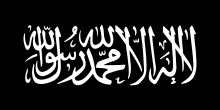Mujahideen in the Bosnian War

So-called mujahedin ( Bosnian mudžahedini ) fought in paramilitary volunteer units alongside the army of Bosnia and Herzegovina during the Bosnian War . The up to 6,000 Muslim volunteers came mainly from Afghanistan , Albania , Chechnya , Egypt , Iran , Jordan , Lebanon , Pakistan , Saudi Arabia , Sudan , Turkey and Yemen . They committed numerous war crimes against Serbs and Croats .
Origin and war effort
Some of them were originally humanitarian workers, while the majority had already fought in Afghanistan and other war zones and were smuggled into Bosnia illegally. These included numerous al-Qaeda supporters who were sent to Bosnia by Osama bin Laden and who fought relatively autonomously throughout the war.
In October 1992 the Bosnian Army set up the 7th Muslim Mountain Brigade ( 7th muslimanska brdska brigada ), which was assigned to the 3rd Zenica Corps . This brigade included the El Mudžahid military unit , which was founded in Travnik on August 13, 1993 and was set up by the Bosnian army to take control of the foreign fighters. The relatively independent fighting unit consisted of 600 Bosniaks and 200 foreign mujahideen. According to a UN - Report of 1995, the unit was dependent on supplies of the Bosnian army. In December 1995, in addition to the 7th, another six light “Muslim Liberation Brigades ” ( Muslimanska oslobodilačka brigada ) were set up and assigned to different corps, namely the 4th, 9th, 17th, 447th, 448th and 807th Brigade. Each of these 2,000-strong brigades consisted of 750 to 1,000 foreign mujahideen.
When arming the Bosnians was UN - arms embargo several times by the United States undermined to supply the Bosnian Army and the Mujahideen with weapons and equipment. US secret services smuggled military equipment through Croatia in cooperation with the Iranian government and the Lebanese Hezbollah .
After the end of the war, the foreign fighters were to leave Bosnia and Herzegovina in accordance with the Dayton Treaty . However, numerous fighters received Bosnian passports. After 2005, Bosnia and Herzegovina withdrew and expelled many former mujahedin citizens from the country. Nevertheless, some of them, especially those who have settled entire villages inland and live in isolation, are still a problem for the authorities today. Well-known mujahideen during this period are Abdelkader Mokhtari , Fateh Kamel and Karim Said Atmani .
War crimes
The atrocities committed by the Mujahideen, especially by the El Mudžahid military unit , took place in central Bosnia and the Ozren region, among others . The Bosnian President Alija Izetbegović and the commander-in-chief of the ARBiH in this area, Rasim Delić , are said to have taken no action against the war crimes after these incidents, apart from initiating investigations.
During the Maline massacre on June 8, 1993, a group of captured Bosnian-Croatian soldiers and civilians were escorted by Bosnian soldiers. 30 of them were taken over by Mujahideen on the way from Maline to Mehurici. When the group reached Bikosi, a prisoner was shot trying to escape. Shortly afterwards, another prisoner started screaming. The mujahideen then opened fire on the prisoners. At least 24 prisoners died and at least 5 prisoners survived injured.
On July 21, 1995, two prisoners were beheaded.
On September 11, 1995, around 60 Serbian soldiers and civilians were captured and, with three exceptions, killed. Three Serbian women were also arrested and taken to a camp. On September 17, 1995, a Serb civilian was captured. He died a few days later from injuries from being hit or from consuming poor quality water, or a combination of both.
Alija Izetbegović thanked the mujahideen several times for what they did. Another important step had been taken in the Bosnian war, said Izetbegović.
The first victims to be excavated were Serbian soldiers and civilians. As the appraiser Sabiha B. Silajdžić says, not a single unearthed victim had a head and many of them were missing a few fingers. Most of the victims were not older than 30 years.
So far, 192 beheading rituals of Serb soldiers and civilians on the part of the mujahideen are known.
Individual evidence
- ↑ Bosnia lakes as Hospitable Base and Sanctuary for Terrorists
- ^ School of Hatred in the Balkans - How bin Laden's Al-Qaida gained a foothold in Bosnia . In: Die Zeit , No. 45/2001
- ^ ICTY - Appeals Chamber - Hadzihasanović and Kubura case
- ^ The American Conservative ( August 24, 2007 memento on the Internet Archive ), The Bosnian Connection, by Brendan O'Neill
- ↑ Dr. Nigel Thomas, Krunoslav Mikulan: The Yugoslav Wars (2): Bosnia, Kosovo and Macedonia 1992–2001 . Osprey Publishing, Oxford 2006, ISBN 978-1-84176-964-6 , pp. 9 .
- ↑ America used Islamists to arm the Bosnian Muslims . In: The Guardian, April 22, 2002
- ↑ Dejan Lukić: Hostage Spaces of the Contemporary Islamicate World , 2012, Continuum Publishing Corporation, p. 55
- ↑ a b c Rasim Delić ICTY Case Information Sheet (PDF; 223 kB), pp. 2–4
- ↑ spiegel.de
- ^ Erich Rathfelder: Intersection Sarajevo . Bosnia and Herzegovina ten years after Dayton, p. 117
- ↑ PLBIH: Vozuca '95 - Alija Izetbegovic. Retrieved January 8, 2019 .
